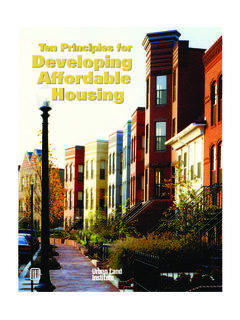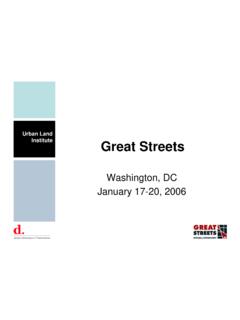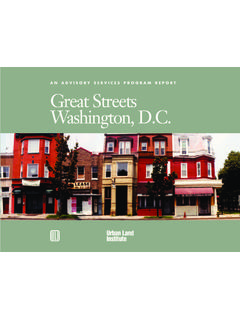Transcription of Ten Principles for Developing Successful Town Centers
1 Urban LandInstitute$Ten Principles forDeveloping Successful Town CentersTen Principles forDeveloping Successful Town Centers10 PTC Cover 6/22/07 10:24 AM Page Covr1 Ten Principles forDeveloping Successful Town CentersMichael D. Beyard Anita KramerBruce LeonardMichael PawlukiewiczDean SchwankeNora Yoo10 Prin TownCtrs 6/21/07 10:33 AM Page iRecommended bibliographic listing: Beyard,Michael D., Anita Kramer, Bruce Leonard,Michael Pawlukiewicz, Dean Schwanke, andNora Yoo. Ten Principles for Developing Success-ful Town Centers . Washington, : ULI theUrban Institute, Order Number T36: Packet of 10 ULI Order Number T37: Single CopyInternational Standard Book Number: 978-0-87420-975-4 Copyright 2007 by ULI the Urban Land Institute1025 Thomas Jefferson Street, 500 WestWashington, 20007-5201 Printed in the United States of America.
2 Allrights reserved. No part of this book may bereproduced in any form or by any means, elec-tronic or mechanical, including photocopyingand recording, or by any information storageand retrieval system, without written permis-sion of the publisher. About ULI the Urban Land InstituteThe mission of the Urban Land Institute is toprovide leadership in the responsible use ofland and in creating and sustaining thrivingcommunities worldwide. ULI is committed to: Bringing together leaders from across thefields of real estate and land use policy toexchange best practices and serve commu-nity needs; Fostering collaboration within and beyondULI s membership through mentoring, dia-logue, and problem solving; Exploring issues of urbanization, conserva-tion, regeneration, land use, capital forma-tion, and sustainable development; Advancing land use policies and design prac-tices that respect the uniqueness of bothbuilt and natural environments; Sharing knowledge through education,applied research, publishing, and electronicmedia.
3 And Sustaining a diverse global network of localpractice and advisory efforts that addresscurrent and future in 1936, the Institute today hasmore than 35,000 members from 90 countries,representing the entire spectrum of the landuse and development disciplines. Professionalsrepresented include developers, builders, prop-erty owners, investors, architects, public offi-cials, planners, real estate brokers, appraisers,attorneys, engineers, financiers, academics,students, and librarians. ULI relies heavily onthe experience of its members. It is throughmember involvement and information resourcesthat ULI has been able to set standards ofexcellence in development Institute has long been recognized as one of the world s most respected and widelyquoted sources of objective information onurban planning, growth, and Project Staff Maureen McAveyExecutive Vice President, InitiativesMichael D.
4 BeyardSenior Resident Fellow, ULI/Martin BucksbaumChair for Retail and EntertainmentDean SchwankeSenior Vice President, Publications and AwardsMichael PawlukiewiczDirector, Environment and Sustainable DevelopmentAnita KramerDirector, Retail DevelopmentNora YooProject AssociateNancy H. StewartDirector, Book ProgramManaging EditorLise Lingo, Publications Professionals LLCM anuscript EditorBetsy VanBuskirkArt DirectorBook and Cover Design; LayoutCraig ChapmanDirector, Publishing OperationsCover photograph: Downtown Silver Spring, SilverSpring, Maryland. The Peterson Prin TownCtrs 6/22/07 10:22 AM Page iiiiiParticipantsChairPeter A. PappasPresident/Managing PartnerPappas Properties, LLCC harlotte, North Carolina DevelopersLeigh M. FergusonEVP, Director of Urban LivingSloss Real EstateBirmingham, Alabama James A.
5 RatnerChief Executive OfficerForest City Commercial Development (Group)Cleveland, OhioYaromir SteinerChief Executive OfficerSteiner + Associates, , Ohio Planners, Urban Designers,ArchitectsMichael D. BeyardULI/Martin Bucksbaum Chair for Retail and EntertainmentWashington, R. CantleyPresident/Chief Executive OfficerCooper Carry, , GeorgiaBruce LeonardPrincipalStreetSense, , Maryland Charles Terry ShookPresidentShook KelleyCharlotte, North Carolina Market SpecialistsMichael P. BuckleyDirector, MSc in Real Estate ProgramColumbia UniversityNew York, New York Robert J. GibbsPresidentGibbs Planning GroupBirmingham, Michigan Gregg T. LoganManaging DirectorRobert Charles Lesser & Co., LLCO rlando, Florida Public OfficialsFrank GrayGeneral ManagerCity of Scottsdale, Arizona Phyllis M.
6 Jarrell Director of PlanningCity of Plano, Texas Philip S. Lanzafame Director of Development ServicesCity of Glendale, California 10 Prin TownCtrs 6/21/07 10:33 AM Page iiiFor more than half a century, suburbanization has been the dominant force inAmerica s metropolitan growth and development. During this period the nation spopulation has shifted dramatically, so that today more Americans live in suburbsthan anywhere else. In fact, two suburbs Mesa, Arizona, and Arlington, Texas arenow among the 50 largest cities in America, and the next census will likely includemore. As suburban populations have soared, along with jobs and shopping opportunities,many suburbanites have happily chosen to live independent of the older cities thatform the core of their metropolitan areas. Many never visit the city except for anoccasional concert, sporting event, or night on the town.
7 At the same time, subur-banites are increasingly aware of the growing shortcomings of their own communi-ties. They do not like monumental traffic jams, deteriorating suburban strips, obso-ivIntroductionVictoria Gardens in Rancho Cucamonga, Cali-fornia, became an instant downtown for anexurban community that needed CITY ENTERPRISES10 Prin TownCtrs 6/21/07 10:33 AM Page ivlete shopping malls, an aging monoculture of single-family homes, and environmen-tal degradation. These problems are all evidence of the lack of a strong civic consequence of the development patterns of the past 50 years is that there arefew public places in suburbia where all segments of society can get together tointeract, to celebrate, to stroll, to protest, to sit and watch the world go by, or justto enjoy day-to-day living.
8 The reason: these types of places are typically found inand around downtowns, and downtowns were never part of the suburban the beginning, suburbs revolved around such private pleasures as backyard bar-becues, football practice, country clubs, and stay-at-home moms. Downtowns wereconsidered anachronisms at best. At worst, they were considered to be filled withcrime, deterioration, poverty, and people to avoid. As a result, suburban downtownsnever got was also designed to be different in the suburbs. Gone were the street-front stores that were intimately connected with the life of the community in began on the Reston TownCenter in Reston, Virginia, in 1990. Today,it continues to Prin TownCtrs 6/21/07 10:33 AM Page vThat eclectic mix of new and old, mom-and-pop stores, and personalized servicewas replaced by more standardized, no-hassle environments with predictablechain stores, mass market appeal, andplentiful parking in an impressive arrayof sophisticated shopping center types,formats, and environments.
9 Gone toowere opportunities to walk to the cornerstore, the movies, the library, the townsquare, or the local caf , because landuses were designed to be separate. Thatmade sense when industrial uses domi-nated cities, but it does not make factors are driving a sea change in suburban attitudes toward cities anddowntowns:1. The typical suburbanite has longer is suburbia dominated bywhite, middle-class couples with chil-dren. Today, the suburbs are as diverseas the cities they surround, in terms ofrace, culture, income, age, sexuality, andlifestyle. This shift suggests that differ-ent development solutions are needed tomeet contemporary needs such as arange of housing types to accommodateall lifestyles at different life-cycle stages. 2. The problems associated in past yearswith downtowns, especially crime, deteri-oration, and visual blight, have dissi-pated.
10 Today, downtowns are cool again. 3. Relentless, low-density suburbandevelopment patterns that require a carto go anywhere are unsustainable, giventhe projected scale of suburban growth. viDesigned in 1922 and built out over years, theiconic Country Club Plaza in Kansas City, Mis-souri, is the forerunner of today s generationof town center NICHOLS10 Prin TownCtrs 6/21/07 10:33 AM Page vi4. There is a powerful desire in suburbia to recreate the sense of community andconnectedness that was lost as metropolitan areas grew so quickly in the past few decades. 5. Suburbanites, like all people, harbor a simple desire for more convenience in theirbusy lives. 6. Smart growth movements are gaining popularity as voters begin to realize thehidden costs of current suburban development practices.











